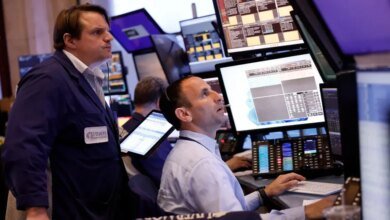Markets expect Trump’s latest China tariffs will backfire as gold jumps and the dollar ‘is not looking looking healthy’

Financial markets suffered another downturn in April, when his “Liberation Day” tariffs shocked global investors, suggesting that his latest tariffs on China may end up hurting the United States more than their intended target.
president Donald Trump said on Friday that he would impose additional 100% tariffs on China and limit US software exports, after China restricted its exports of rare earth elements.
The S&P 500 fell 2.7%, its worst sell-off since April 10. Meanwhile, the US dollar index fell by about 0.7% as Treasury yields fell, while gold prices rose by more than 1.5%.
“Markets once again believe the U.S. has the shortest straw in the tariff battle with China,” Robin Brooks, a senior fellow at the Brookings Institution, wrote in Substack on Saturday.
China dominates rare earths, producing more than 90% of the world’s rare earth elements and rare earth magnets. This served as a major source of pressure on the United States
The difference between the dollar and gold is notable because historically stock market sell-offs have pushed investors to the dollar as a safe haven.
But just like in the fallout from Liberation Day, this dollar pattern did not continue, and instead gold was the preferred haven from the trade war chaos.
Brooks pointed out that the dollar has been stable in recent weeks even as gold prices rose, recording record high after record high. This ended with Trump announcing tariffs on China on Friday.
He added: “This is the second time that markets have traded tariffs as being counterproductive to the United States, and not to the rest of the world.”
Looking at how stocks, currencies and gold reacted on Friday, Brooks said the overall picture is that the dollar actually looks more vulnerable now than it did in early April.
He particularly noted how low the dollar was when compared to the sharp decline in stocks, which usually boosts the US currency amid a flight to safety.
“The fact that this did not happen and that gold prices are higher than they were on liberation day is worrying,” Brooks warned. “The dollar does not look healthy.”
Before the tariffs erupted, trade talks between the US and China were progressing after Trump reached agreements with the European Union, Japan, South Korea and other major trading partners.
But tensions remain, including the issue of rare earths, while the United States has moved to restrict other countries’ exports of semiconductor-related products to China.
Also this week, the United States announced port fees on Chinese ships, prompting Beijing to impose similar fees on American ships calling at Chinese ports. China has also launched an antitrust investigation into US chipmaker Qualcomm.
Then on Thursday, China’s Ministry of Commerce said that starting on December 1, a license would be required for foreign companies to export products containing more than 0.1% rare earth elements from China or made using Chinese production technology.
“In other words, the United States can cut off China from today’s chips, but China can make it very difficult to build the chips and other advanced technologies of tomorrow,” Michael Froman, president of the Council on Foreign Relations and a former US trade representative, said in a post on Friday.
Don’t miss more hot News like this! Click here to discover the latest in Business news!
2025-10-11 16:14:00




